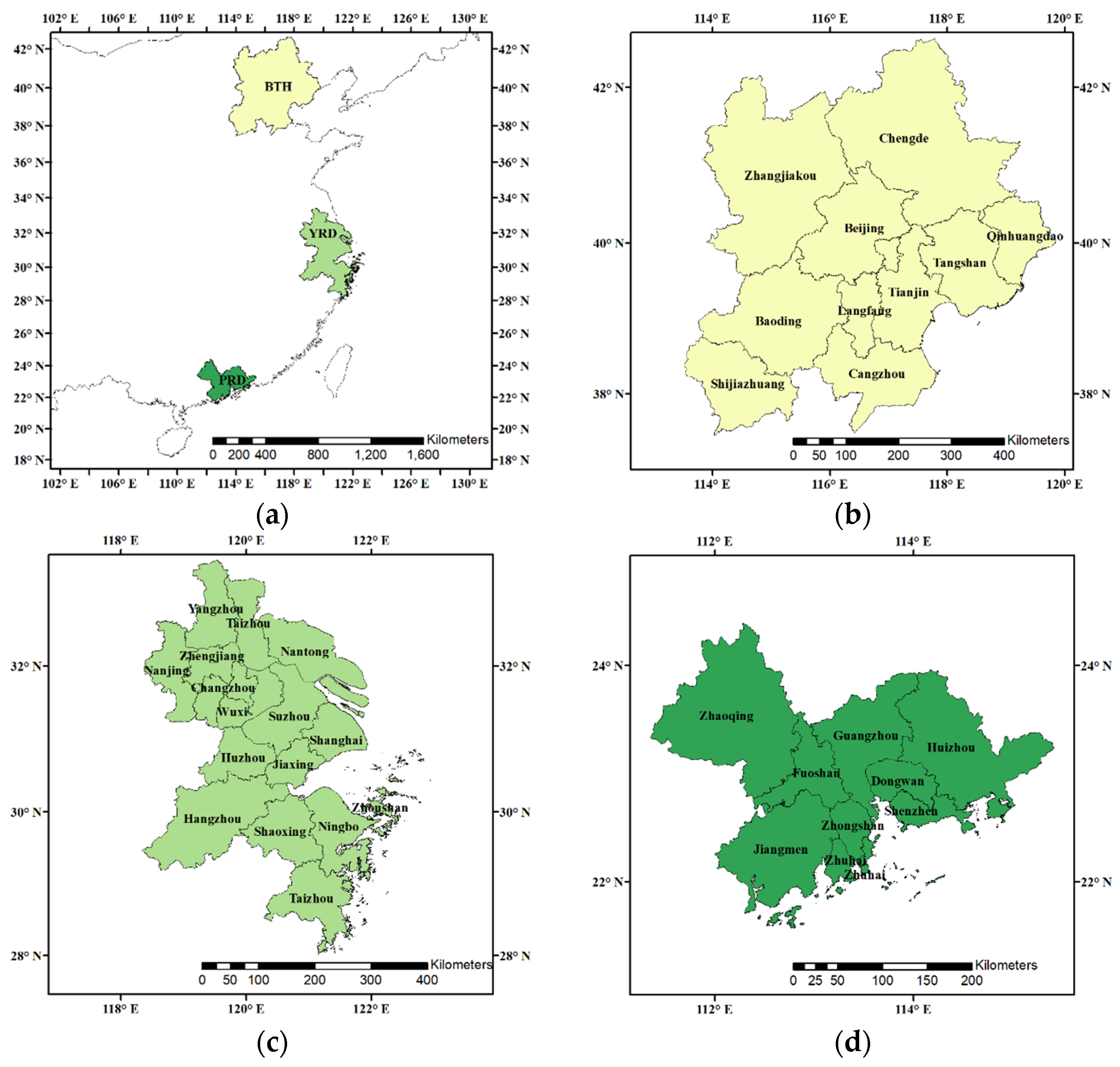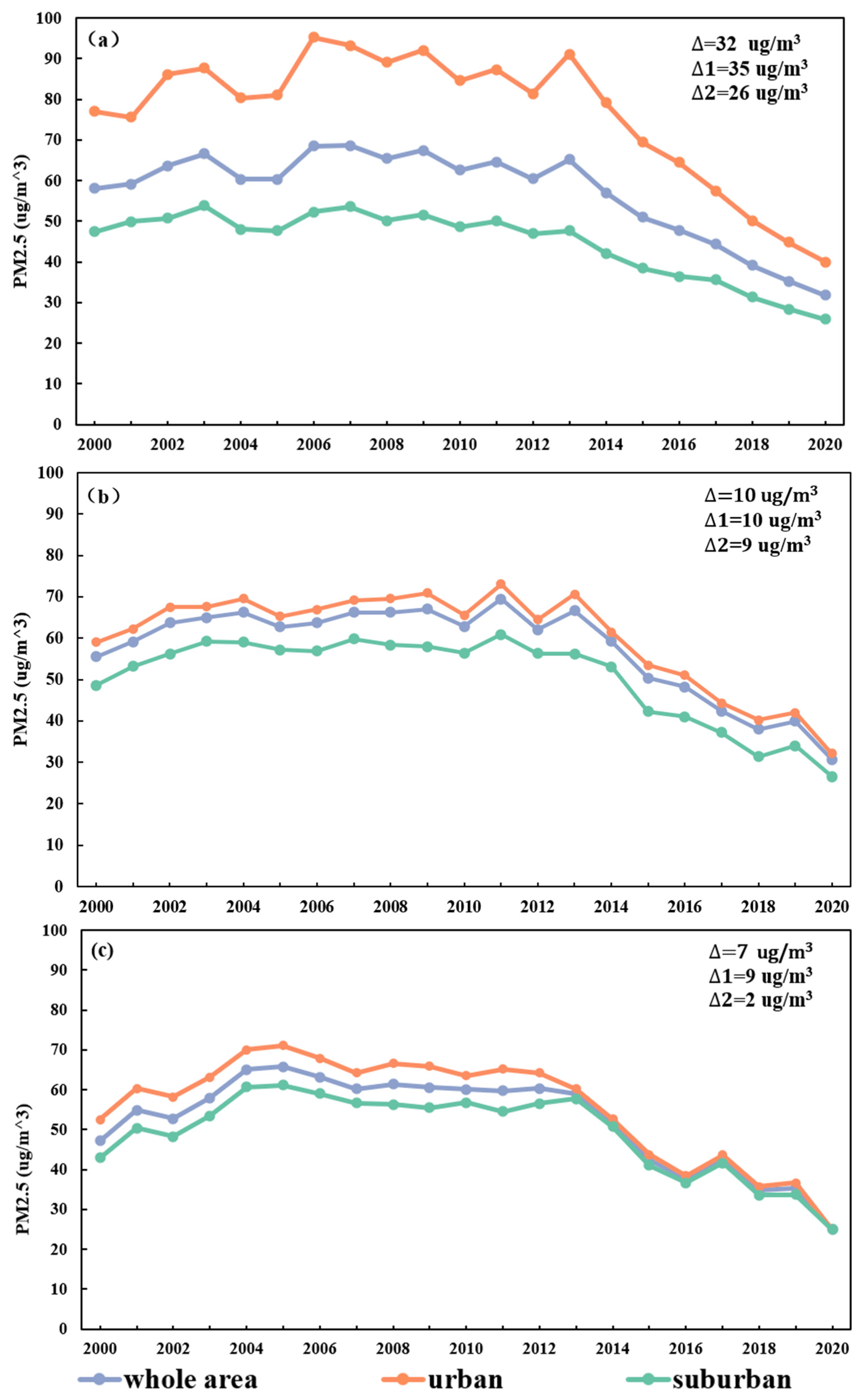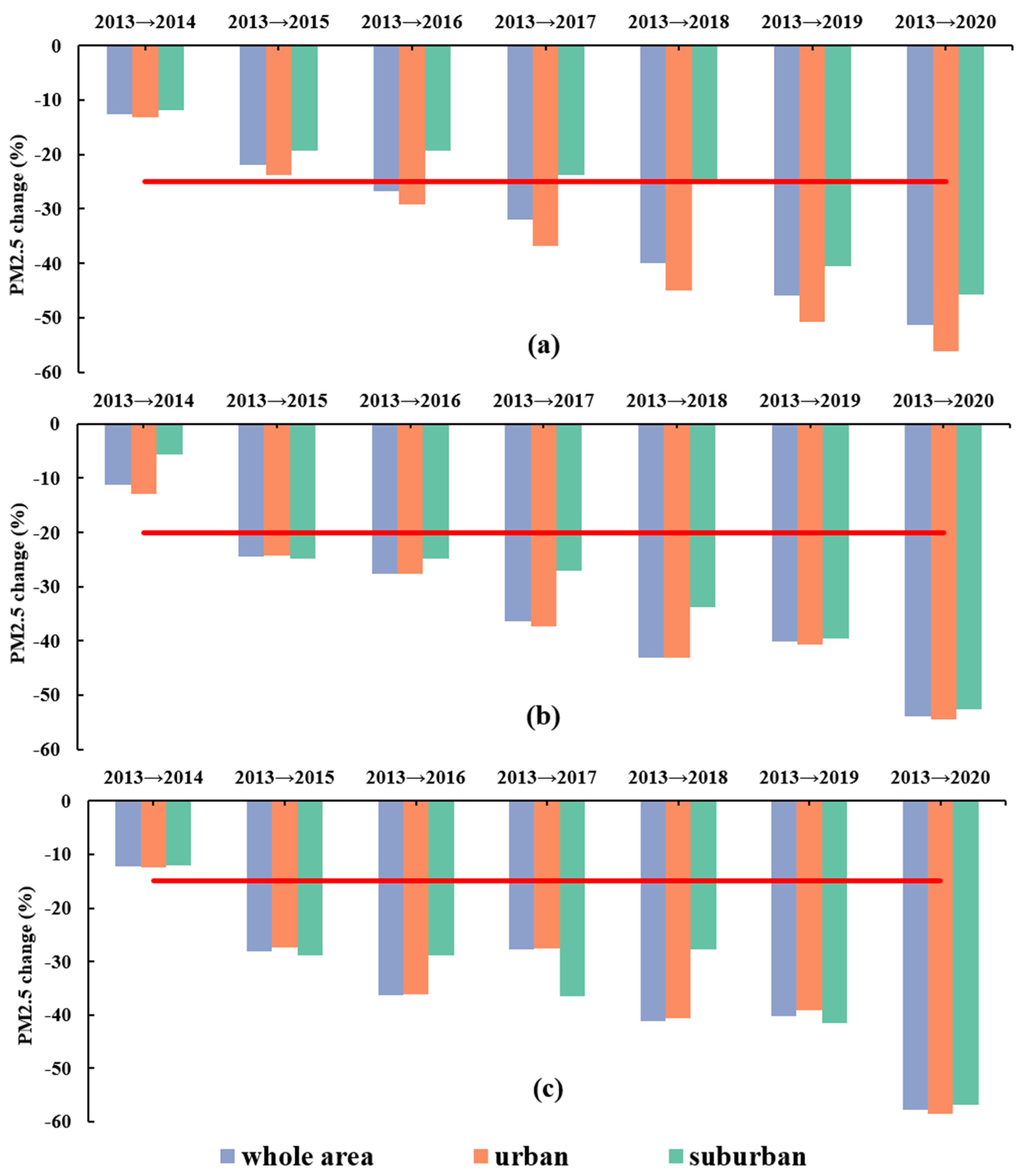Changes in Long-Term PM2.5 Pollution in the Urban and Suburban Areas of China’s Three Largest Urban Agglomerations from 2000 to 2020
Abstract
:1. Introduction
2. Materials and Methods
2.1. Study Area
2.2. Data Sources
2.3. Classification Method Used to Delineate Urban and Suburban Areas
2.4. Statistical Analysis Methods
2.5. PM2.5 Exposure Risk
3. Results
3.1. The Variations of the Extents of Urban and Suburban Areas
3.2. PM2.5 Disparities between Urban and Suburban Areas
3.3. The Effect of China’s Clean Air Policies on Urban–Suburban Areas
3.4. PM2.5 Exposure Risks Vary in Urban and Suburban Areas
4. Discussion
5. Conclusions
Author Contributions
Funding
Institutional Review Board Statement
Informed Consent Statement
Data Availability Statement
Acknowledgments
Conflicts of Interest
References
- World Health Organization. Burden of Disease from Ambient Air Pollution for 2016; World Health Organization: Geneva, Switzerland, 2018. [Google Scholar]
- Mar, T.F.; Ito, K.; Koenig, J.Q.; Larson, T.V.; Eatough, D.J.; Henry, R.C.; Kim, E.; Laden, F.; Lall, R.; Neas, L.; et al. PM source apportionment and health effects. 3. Investigation of inter-method variations in associations between estimated source contributions of PM2. 5 and daily mortality in Phoenix, AZ. J. Expo. Sci. Environ. Epidemiol. 2006, 16, 311–320. [Google Scholar] [CrossRef] [PubMed] [Green Version]
- Fang, D.; Chen, B.; Hubacek, K.; Ni, R.; Chen, L.; Feng, K.; Lin, J. Clean air for some: Unintended spillover effects of regional air pollution policies. Sci. Adv. 2019, 5, eaav4707. [Google Scholar] [CrossRef] [PubMed] [Green Version]
- Kan, H.; Chen, R.; Tong, S. Ambient air pollution, climate change, and population health in China. Environ. Int. 2012, 42, 10–19. [Google Scholar] [CrossRef] [PubMed]
- Hoek, G.; Krishnan, R.M.; Beelen, R.; Peters, A.; Ostro, B.; Brunekreef, B.; Kaufman, J.D. Long-term air pollution exposure and cardio- respiratory mortality: A review. Environ. Health 2013, 12, 43. [Google Scholar] [CrossRef] [Green Version]
- Forouzanfar, M.H.; Afshin, A.; Alexander, L.T.; Anderson, H.R.; Bhutta, Z.A.; Biryukov, S.; Brauer, M.; Burnett, R.; Cercy, K.; Charlson, F.J.; et al. Global, regional, and national comparative risk assessment of 79 behavioural, environmental and occupational, and metabolic risks or clusters of risks, 1990–2015: A systematic analysis for the Global Burden of Disease Study 2015. Lancet 2017, 388, 1659–1724. [Google Scholar] [CrossRef] [Green Version]
- State Council of People’s Republic of China. The Air Pollution Prevention and Control Action Plan 2013; State Council of People’s Republic of China: Beijing, China, 2013. (In Chinese) [Google Scholar]
- State Council of People’s Republic of China. The Thirtieth Five-Year Plan for Ecological Environment Protection; State Council of People’s Republic of China: Beijing, China, 2016. (In Chinese) [Google Scholar]
- Yan, D.; Lei, Y.; Shi, Y.; Zhu, Q.; Li, L.; Zhang, Z. Evolution of the spatiotemporal pattern of PM2. 5 concentrations in China–A case study from the Beijing-Tianjin-Hebei region. Atmos. Environ. 2018, 183, 225–233. [Google Scholar]
- Wang, Y.; Liu, H.; Mao, G.; Zuo, J.; Ma, J. Inter-regional and sectoral linkage analysis of air pollution in Beijing–Tianjin–Hebei (Jing-Jin-Ji) urban agglomeration of China. J. Clean. Prod. 2017, 165, 1436–1444. [Google Scholar] [CrossRef]
- Zhai, S.; Jacob, D.J.; Wang, X.; Shen, L.; Li, K.; Zhang, Y.; Gui, K.; Zhao, T.; Liao, H. Fine particulate matter (PM2.5) trends in China, 2013–2018: Separating contributions from anthropogenic emissions and meteorology. Atmos. Chem. Phys. 2019, 19, 11031–11041. [Google Scholar] [CrossRef] [Green Version]
- Du, Y.; Sun, T.; Peng, J.; Fang, K.; Liu, Y.; Yang, Y.; Wang, Y. Direct and spillover effects of urbanization on PM2.5 concentrations in China’s top three urban agglomerations. J. Clean. Prod. 2018, 190, 72–83. [Google Scholar] [CrossRef]
- Fang, C.; Yu, D. China’s New Urbanization: Developmental Paths, Blueprints and Patterns; Springer: Berlin, Germany; Beijing, China, 2016. [Google Scholar]
- State Council of People’s Republic of China. New National Urbanization Plan (2014–2020); State Council of People’s Republic of China: Beijing, China, 2014. (In Chinese) [Google Scholar]
- Bai, X.; Shi, P.; Liu, Y. Society: Realizing China’s Urban Dream. Nature 2014, 509, 158–160. [Google Scholar] [CrossRef] [Green Version]
- Tie, X.; Cao, J. Aerosol pollution in China: Present and future impact on environment. Particuology 2009, 7, 426–431. [Google Scholar] [CrossRef]
- Zhao, X.J.; Zhao, P.S.; Xu, J.; Meng, W.; Pu, W.W.; Dong, F.; He, D.; Shi, Q.F. Analysis of a winter regional haze event and its formation mechanism in the North China Plain. Atmos. Chem. Phys. 2013, 13, 5685–5696. [Google Scholar] [CrossRef] [Green Version]
- Batterman, S.; Xu, L.; Chen, F.; Zhong, X. Characteristics of PM2.5 concentrations across Beijing during 2013–2015. Atmos. Environ. 2016, 145, 104–114. [Google Scholar] [CrossRef] [PubMed] [Green Version]
- Chen, W.; Tang, H.Z.; Zhao, H.M. Diurnal, weekly and monthly spatial variations of air pollutants and air quality of Beijing. Atmos. Environ. 2015, 119, 21–34. [Google Scholar] [CrossRef]
- Wu, J.; Xie, W.; Li, W.; Li, J. Effects of Urban Landscape Pattern on PM2.5 Pollution—A Beijing Case Study. PLoS ONE 2015, 10, e0142449. [Google Scholar]
- Han, L.; Zhou, W.; Li, W. Fine particulate (PM2.5) dynamics during rapid urbanization in Beijing, 1973–2013. Sci. Rep. 2016, 6, 23604. [Google Scholar] [CrossRef] [PubMed] [Green Version]
- Zhang, X.; Wang, L.; Wang, W.; Cao, D.; Wang, X.; Ye, D. Long-term trend and spatiotemporal variations of haze over China by satellite observations from 1979 to 2013. Atmos. Environ. 2015, 119, 362–373. [Google Scholar] [CrossRef]
- Huang, W.; Long, E.; Wang, J.; Huang, R.; Ma, L. Characterizing spatial distribution and temporal variation of PM10 and PM2.5 mass concentrations in an urban area of Southwest China. Atmos. Pollut. Res. 2015, 6, 842–848. [Google Scholar] [CrossRef]
- Wang, Y.Q.; Zhang, X.Y.; Sun, J.Y.; Zhang, X.C.; Chen, H.Z.; Li, Y. Spatial and temporal variations of the concentrations of PM10, PM2.5 and PM1 in China. Atmos. Chem. Phys. 2015, 15, 13585–13598. [Google Scholar] [CrossRef] [Green Version]
- Yang, Y.; Christakos, G. Spatiotemporal Characterization of Ambient PM2.5 Concentrations in Shandong Province (China). Environ. Sci. Technol. 2015, 49, 13431–13438. [Google Scholar] [CrossRef]
- Liu, M.; Bi, J.; Ma, Z. Visibility-based PM2.5 concentrations in China: 1957–1964 and 1973–2014. Environ. Sci. Technol. 2017, 51, 13161–13169. [Google Scholar] [PubMed]
- Han, L.; Zhou, W.; Li, W.; Li, L. Impact of urbanization level on urban air quality: A case of fine particles (PM2.5) in Chinese cities. Environ. Pollut. 2014, 194, 163–170. [Google Scholar] [CrossRef] [PubMed]
- Han, L.J.; Zhou, W.Q.; Li, W.F. City as a major source area of fine particulate (PM2.5) in China. Environ. Pollut. 2015, 206, 183–187. [Google Scholar] [CrossRef] [PubMed]
- Zhang, Y.-L.; Cao, F. Fine particulate matter (PM2.5) in China at a city level. Sci. Rep. 2015, 5, 14884. [Google Scholar]
- Yao, L.; Lu, N. Spatiotemporal distribution and short-term trends of particulate matter concentration over China, 2006–2010. Environ. Sci. Pollut. Res. 2014, 21, 9665–9675. [Google Scholar] [CrossRef]
- Shi, T.; Han, G.; Ma, X.; Gong, W.; Chen, W.; Liu, J.; Zhang, X.; Pei, Z.; Gou, H.; Bu, L. Quantifying CO2 Uptakes Over Oceans Using LIDAR: A Tentative Experiment in Bohai Bay. Geophys. Res. Lett. 2021, 48, e2020GL091160. [Google Scholar] [CrossRef]
- Pei, Z.; He, G.; Ma, X.; Su, H.; Gong, W. Response of major air pollutants to COVID-19 lockdowns in China. Sci. Total Environ. 2020, 743, 140879. [Google Scholar] [CrossRef]
- Li, X.; Ma, Y.; Wang, Y.; Liu, N.; Hong, Y. Temporal and spatial analyses of particulate matter (PM10 and PM2.5) and its relationship with meteorological parameters over an urban city in northeast China. Atmos. Res. 2017, 198, 185–193. [Google Scholar] [CrossRef]
- Lou, C.-R.; Liu, H.-Y.; Li, Y.-F.; Li, Y.-L. Socioeconomic Drivers of PM2.5 in the Accumulation Phase of Air Pollution Episodes in the Yangtze River Delta of China. Int. J. Environ. Res. Public Health 2016, 13, 928. [Google Scholar] [CrossRef] [Green Version]
- Chan, C.K.; Yao, X. Air pollution in mega cities in China. Atmos. Environ. 2008, 42, 1–42. [Google Scholar] [CrossRef]
- von Bismarck-Osten, C.; Birmili, W.; Ketzel, M.; Massling, A.; Petäjä, T.; Weber, S. Characterization of parameters influencing the spatio-temporal variability of urban particle number size distributions in four European cities. Atmos. Environ. 2013, 77, 415–429. [Google Scholar] [CrossRef]
- Zhao, X.; Zhang, X.; Xu, X.; Xu, J.; Meng, W.; Pu, W. Seasonal and diurnal variations of ambient PM2.5 concentration in urban and rural environments in Beijing. Atmos. Environ. 2009, 43, 2893–2900. [Google Scholar] [CrossRef]
- Lin, C.; Lau, A.K.H.; Li, Y.; Fung, J.C.H.; Li, C.; Lu, X.; Li, Z. Difference in PM2.5 Variations between Urban and Rural Areas over Eastern China from 2001 to 2015. Atmosphere 2018, 9, 312. [Google Scholar] [CrossRef] [Green Version]
- Dijkstra, L.; Florczyk, A.J.; Freire, S.; Kemper, T.; Melchiorri, M.; Pesaresi, M.; Schiavina, M. Applying the Degree of Urbanisation to the globe: A new harmonised definition reveals a different picture of global urbanisation. J. Urban Econ. 2021, 125, 103312. [Google Scholar] [CrossRef]
- Zhang, L.; Wilson, J.P.; MacDonald, B.; Zhang, W.; Yu, T. The changing PM2.5 dynamics of global megacities based on long-term remotely sensed observations. Environ. Int. 2020, 142, 105862. [Google Scholar] [CrossRef] [PubMed]
- Wei, J.; Li, Z.; Cribb, M.; Huang, W.; Xue, W.; Sun, L.; Guo, J.; Peng, Y.; Li, J.; Lyapustin, A. Improved 1 km resolution PM2.5 estimates across China using enhanced space–time extremely randomized trees. Atmos. Chem. Phys. 2020, 20, 3273–3289. [Google Scholar] [CrossRef] [Green Version]
- Wei, J.; Li, Z.; Lyapustin, A.; Sun, L.; Peng, Y.; Xue, W.; Su, T.; Cribb, M. Reconstructing 1-km-resolution high-quality PM2. 5 data records from 2000 to 2018 in China: Spatiotemporal variations and policy implications. Remote Sens. Environ. 2021, 252, 112136. [Google Scholar] [CrossRef]
- Center for International Earth Science Information Network—CIESIN—Columbia University. Documentation for the Gridded Population of the World, Version 4 (GPWv4); NASA Socioeconomic Data and Applications Center (SEDAC): Palisades, NY, USA, 2016; Available online: https://sedac.ciesin.columbia.edu/data/collection/gpw-v4/documentation (accessed on 4 August 2020).
- Doxsey-Whitfield, E.; MacManus, K.; Adamo, S.B.; Pistolesi, L.; Squires, J.; Borkovska, O.; Baptista, S.R. Taking advantage of the improved availability of census data: A first look at the gridded population of the world, version 4. Pap. Appl. Geogr. 2015, 1, 226–234. [Google Scholar] [CrossRef]
- ESRI. Performing Sensitivity Analysis. Available online: http://webhelp.esri.com/arcgisdesktop/9.2/index.cfm?TopicName=Performing_sensitivity_analysis (accessed on 4 March 2021).
- Zhang, L.; Pan, J. Spatial-temporal pattern of population exposure risk to PM2.5 in China. China Environ. Sci. 2020, 40, 1–12. [Google Scholar]
- Dijkstra, L.; Poelman, H. A harmonised definition of cities and rural areas: The new degree of urbanisation. European Comission Directorate-General for Regional and Urban Policy. Reg. Work. Pap. 2014, 1, 1–14. [Google Scholar]
- Gong, P.; Li, X.; Zhang, W. 40-Year (1978–2017) human settlement changes in China reflected by impervious surfaces from satellite remote sensing. Sci. Bull. 2019, 64, 756–763. [Google Scholar] [CrossRef] [Green Version]
- Xiao, Q.; Geng, G.; Liang, F.; Wang, X.; Lv, Z.; Lei, Y.; Huang, X.; Zhang, Q.; Liu, Y.; He, K. Changes in spatial patterns of PM2.5 pollution in China 2000–2018: Impact of clean air policies. Environ. Int. 2020, 141, 105776. [Google Scholar] [CrossRef] [PubMed]
- Zhou, Y.; Smith, S.J.; Elvidge, C.D.; Zhaom, K.; Thomson, A.; Imhoff, M. A cluster-based method to map urban area from DMSP/OLS nightlights. Remote Sens. Environ. 2014, 147, 173–185. [Google Scholar] [CrossRef]
- Wang, S.; Sun, P.; Sun, F.; Jiang, S.; Zhang, Z.; Wei, G. The Direct and Spillover Effect of Multi-Dimensional Urbanization on PM2.5 Concentrations: A Case Study from the Chengdu-Chongqing Urban Agglomeration in China. Int. J. Environ. Res. Public. Health. 2021, 18, 10609. [Google Scholar] [CrossRef]
- Ma, Z.; Liu, R.; Liu, Y.; Bi, J. Effects of air pollution control policies on PM2.5 pollution improvement in China from 2005 to 2017: A satellite-based perspective. Atmos. Chem. Phys. 2019, 19, 6861–6877. [Google Scholar] [CrossRef] [Green Version]
- State Council of People’s Republic of China. Guidelines on Promoting the Relocation and Transformation of Hazardous Chemical Production Enterprises in Densely Populated Areas; State Council of People’s Republic of China: Beijing, China, 2017. (In Chinese) [Google Scholar]
- World Health Organization; WHO European Centre for Environment. W.E.C.F. Environment. WHO Global Air Quality Guidelines: Particulate Matter (PM2.5 and PM10), Ozone, Nitrogen Dioxide, Sulfur Dioxide and Carbon Monoxide; World Health Organization: Geneva, Switzerland, 2021. [Google Scholar]
- World Health Organization. Air Quality Guidelines: Global Update 2005: Particulate Matter, Ozone, Nitrogen Dioxide, and Sulfur Dioxide; World Health Organization: Geneva, Switzerland, 2006. [Google Scholar]





| Region | Year | Urban | Suburban | ||
|---|---|---|---|---|---|
| Area (km2) | Pop. (Thousands) | Area (km2) | Pop. (Thousands) | ||
| BTH | 2000 | 112,000 | 61,125 | 200,000 | 9699 |
| 2005 | 117,000 | 67,514 | 195,000 | 9309 | |
| 2010 | 121,000 | 74,590 | 191,000 | 9089 | |
| 2015 | 125,000 | 82,669 | 187,000 | 8850 | |
| 2020 | 130,000 | 91,962 | 182,000 | 8542 | |
| Percent Change (%) | 4 | 11 | −2 | −3 | |
| YRD | 2000 | 100,000 | 84,436 | 54,000 | 4590 |
| 2005 | 104,000 | 93,103 | 50,000 | 4391 | |
| 2010 | 107,000 | 102,965 | 47,000 | 4208 | |
| 2015 | 110,000 | 114,276 | 44,000 | 3949 | |
| 2020 | 114,000 | 127,228 | 40,000 | 3632 | |
| Percent Change (%) | 5 | 11 | −4 | −6 | |
| PRD | 2000 | 29,000 | 40,297 | 36,000 | 3592 |
| 2005 | 30,000 | 45,725 | 35,000 | 3715 | |
| 2010 | 32,000 | 52,024 | 33,000 | 3818 | |
| 2015 | 34,000 | 59,598 | 31,000 | 3638 | |
| 2020 | 35,000 | 68,136 | 30,000 | 3654 | |
| Percent Change (%) | 3 | 14 | −7 | 0 | |
| Year | BTH | YRD | PRD | |||
|---|---|---|---|---|---|---|
| Urban | Suburban | Urban | Suburban | Urban | Suburban | |
| 2013 | 91.08 | 47.72 | 70.60 | 56.21 | 60.18 | 57.70 |
| 2014 | 79.17 | 42.09 | 61.51 | 53.08 | 52.70 | 50.70 |
| 2015 | 69.47 | 38.48 | 53.46 | 42.28 | 43.77 | 41.10 |
| 2016 | 64.47 | 36.41 | 51.03 | 41.01 | 38.48 | 36.66 |
| 2017 | 57.48 | 35.54 | 44.29 | 37.22 | 43.63 | 41.66 |
| 2018 | 50.12 | 31.33 | 40.19 | 31.33 | 35.75 | 33.60 |
| 2019 | 44.78 | 28.34 | 41.94 | 33.96 | 36.69 | 33.71 |
| 2020 | 39.97 | 25.93 | 32.10 | 26.59 | 24.95 | 24.90 |
| −7.30 | −3.11 | −5.50 | −4.23 | −5.03 | −4.69 | |
| Year | BTH | YRD | PRD | |||
|---|---|---|---|---|---|---|
| Urban | Suburban | Urban | Suburban | Urban | Suburban | |
| 2000 | 2.48 | 0.16 | 1.45 | 0.13 | 2.09 | 0.12 |
| 2005 | 2.42 | 0.14 | 1.41 | 0.13 | 2.02 | 0.12 |
| 2010 | 2.36 | 0.12 | 1.37 | 0.12 | 1.94 | 0.12 |
| 2015 | 2.31 | 0.11 | 1.34 | 0.10 | 1.82 | 0.11 |
| 2020 | 2.23 | 0.11 | 1.31 | 0.09 | 1.74 | 0.11 |
| −0.06 | −0.01 | −0.04 | −0.01 | −0.09 | −0.003 | |
Publisher’s Note: MDPI stays neutral with regard to jurisdictional claims in published maps and institutional affiliations. |
© 2022 by the authors. Licensee MDPI, Basel, Switzerland. This article is an open access article distributed under the terms and conditions of the Creative Commons Attribution (CC BY) license (https://creativecommons.org/licenses/by/4.0/).
Share and Cite
Zhang, L.; Zhao, N.; Zhang, W.; Wilson, J.P. Changes in Long-Term PM2.5 Pollution in the Urban and Suburban Areas of China’s Three Largest Urban Agglomerations from 2000 to 2020. Remote Sens. 2022, 14, 1716. https://doi.org/10.3390/rs14071716
Zhang L, Zhao N, Zhang W, Wilson JP. Changes in Long-Term PM2.5 Pollution in the Urban and Suburban Areas of China’s Three Largest Urban Agglomerations from 2000 to 2020. Remote Sensing. 2022; 14(7):1716. https://doi.org/10.3390/rs14071716
Chicago/Turabian StyleZhang, Lili, Na Zhao, Wenhao Zhang, and John P. Wilson. 2022. "Changes in Long-Term PM2.5 Pollution in the Urban and Suburban Areas of China’s Three Largest Urban Agglomerations from 2000 to 2020" Remote Sensing 14, no. 7: 1716. https://doi.org/10.3390/rs14071716
APA StyleZhang, L., Zhao, N., Zhang, W., & Wilson, J. P. (2022). Changes in Long-Term PM2.5 Pollution in the Urban and Suburban Areas of China’s Three Largest Urban Agglomerations from 2000 to 2020. Remote Sensing, 14(7), 1716. https://doi.org/10.3390/rs14071716







